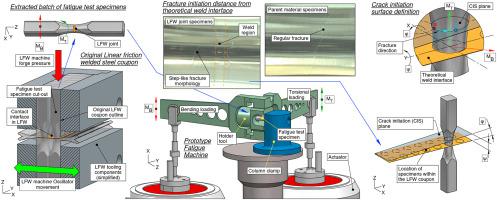Precision Engineering ( IF 3.5 ) Pub Date : 2021-03-09 , DOI: 10.1016/j.precisioneng.2021.02.008 Robert Owsiński , Dorian S. Lachowicz , Cyprian T. Lachowicz , Roberto Gil , Adam Niesłony

|
Linear friction welding (LFW) is widely used for the fabrication of high-value components in the aero-industry. The versatility of use and high integrity of joints produced by LFW, suggest that this technology could contribute greatly to sustainable engineering of the future. For example, in near-net-shape manufacturing, LFW is predicted to offer a substantial reduction in material waste and processing time, in addition to offering the capability of bonding material pairs currently difficult to fusion weld. LFW of steel components is seldom researched in published literature, with little information available on fatigue strength and fracture behaviour of such joints. This may hamper the confidence needed to popularise LFW in wider industry. Thusly, authors conducted a discovery-oriented fatigue study, followed by metallography and micro-hardness tests, conducted on a 100Cr steel LFW coupon and corresponding batch of parent material. The weld coupon was dissected into a set of fatigue specimens, to allow mapping of the joint's internal properties through individual fatigue estimates and fracture morphology of each specimen in the set. A prototype fatigue machine was constructed, designed to deliver independent displacement and force controlled bending or torsional loadings, representing complex real-world conditions more accurately than common, uniaxial tests. The hour-glass shape of fatigue specimens allowed for targeting strictly the weld region, inducing fracture at the weakest material section, which was found to lay far outside the immediate contact interface. Referencing distances from fracture points to the theoretical weld interface plane in each fatigue trial, resulted in discovery of a macroscopic pattern. Interpolated to a crack initiation plane, this pattern is proposed to reflect the heat-affected zone, across the greater LFW coupon. Authors also studied crack paths and suggest a link between fracture direction, residual stresses in joint and angular orientation of the crack initiation plane in respect to the theoretical weld interface.
中文翻译:

通过从线性摩擦焊接钢试样中提取疲劳试样中的裂纹的空间分布图来表征接头性能
线性摩擦焊接(LFW)被广泛用于航空工业中高价值部件的制造。LFW生产的接头用途广泛且具有很高的完整性,这表明该技术可以为未来的可持续工程做出巨大贡献。例如,在近最终形状的制造中,预计LFW除了具有粘结目前难以熔焊的材料对的能力之外,还可以大大减少材料浪费和加工时间。在公开的文献中很少研究钢构件的LFW,有关这种接头的疲劳强度和断裂行为的信息很少。这可能会妨碍在更广泛的行业中普及LFW所需的信心。因此,作者进行了以发现为导向的疲劳研究,然后对100Cr钢LFW试样和相应批次的母体材料进行金相和显微硬度测试。将焊缝试样分解为一组疲劳试样,以允许通过单独的疲劳估计和该组中每个试样的断裂形态来绘制接头的内部特性。构造了原型疲劳机,旨在提供独立的位移和受力控制的弯曲或扭转载荷,比普通的单轴测试更准确地表示复杂的实际条件。疲劳试样的沙漏形允许严格地对准焊接区域,从而在最薄的材料部分引起断裂,该断裂被发现位于直接接触界面之外。在每次疲劳试验中,参考从断裂点到理论焊接界面平面的距离,都会发现宏观模式。内插到裂纹起始平面上,提出了这种模式以反映整个较大的LFW试样的热影响区。作者还研究了裂纹路径,并提出了断裂方向,接头残余应力与裂纹起始平面相对于理论焊接界面的角度方向之间的联系。











































 京公网安备 11010802027423号
京公网安备 11010802027423号